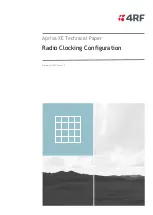
OPERATION
2-18
November 2001
Part No. 001-7240-001
2.7.6 RECALLING NUMBERS FROM MEMORY
From Specific Location - FCN RCL 0-9 (location
number)
Stored in Next Location - When a number is recalled as
just described, the number in the next location can be
displayed by simply pressing RCL.
Last Number Recalled from Memory - FCN RCL
Last Number Sent by FCN SND - FCN RCL
2.7.7 EXITING DIAL MODE
The dial mode is automatically exited when
power is cycled or approximately 60 seconds after no
keys are pressed. It can also be exited as follows:
Exiting Without Sending Call Termination Characters -
Press FCN DIAL. The call termination characters
should then be sent manually before exiting (see
following).
Exiting and Automatically Sending Call Termination
Characters - Press FCN PHONE and the call termina-
tion characters (
) are automatically sent to indicate
to the base equipment that the call is complete. Three
beeps sound when the call is successfully terminated.
If the call is not terminated in this manner, the
repeater being used is held until the end of the call is
detected automatically, such as by the absence of
voice. This occurs because with telephone and auxil-
iary calls, the repeater is held for the duration of the
call instead of just for the duration of a transmission as
with standard group calls.
2.8 LTR-NET AND LTR FEATURES
2.8.1 STANDARD GROUP CALLS
Standard group (dispatch) calls are between
mobiles or groups of mobiles using the standard group
ID codes from 1-239 (LTR-Net) or 1-250 (LTR) that are
assignable to each home repeater. LTR-Net and LTR
standard calls are very similar and are placed and
received using the same procedure. Simply select a
group programmed with the ID code of the mobile
being called and then press the PTT switch. No number
is dialed to place this type of call.
To receive a standard group call, the group
programmed with the ID code being transmitted must
be selected or scanned. Calls with a higher priority
than the selected group are always received as
described in Section 2.8.2. The procedure used to
place and receive standard group calls is described in
Section 2.3.13.
2.8.2 CALLS ON PRIORITY ID CODES
LTR-Net transceivers use a different receive
priority scheme than has been used with other E.F.
Johnson transceivers. Instead of programming each
selectable system with one or two fixed priority ID
codes, each group is assigned a priority number which
determines if a call on that group can interrupt a call
on another group in that system. The following
priority information is programmed for each LTR-Net
and LTR group:
•
Priority number from 1-8.
•
Interruptible or not interruptible.
The highest priority is programmed by “1” and
the lowest priority by “8”. When any priority 1 group
in the current system is displayed,
is indicated in
the upper part of the display, and when any priority 2
group is displayed,
is indicated. Priority 3-8 groups
are not indicated.
If any type of call (standard, telephone, auxil-
iary) is detected on any group of the selected system
that has a higher priority than the selected group or the
call being received, it is received even if group scan-
ning is not enabled. Exceptions are if the group is not
in the group scan list or the current call is on a group
programmed as not interruptible.
Standard group calls with a lower priority than
the selected group are received only if group scanning
is enabled. Telephone and auxiliary calls of any
priority are always received if they are on a group in
the group scan list and no other call is being received.
If another call is being received, they are received only
if they have a higher priority than the current call.
If calls on certain groups are not to be interrupted
by higher priority calls, the group can be programmed
as not interruptible (telephone and auxiliary calls are
never interrupted by other calls). For example, if calls
on a certain group are not to be interrupted, that group
#
#
















































